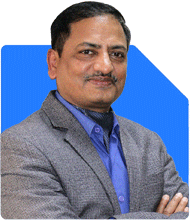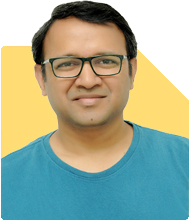Can I Build a 5 Crore Retirement Corpus With These Mutual Funds?
Ramalingam Kalirajan |10031 Answers |Ask -Follow
Mutual Funds, Financial Planning Expert - Answered on Oct 11, 2024
He has an MBA in finance from the University of Madras and is a certified financial planner.
He is the director and chief financial planner at Holistic Investment, a Chennai-based firm that offers financial planning and wealth management advice.... more

Hello Sir, I'm 45 years and starting my MF investment journey, I've selected the below MFs to invest in from a view for my Retirement Planning, If I intend to build a corpus of 5 Cr by 60 yrs of age, are these the right MFs to go with, or do you suggest swapping these for any better ones, kindly suggest. Also can you pls suggest how much amount should I invest lumpsum and via SIPs in these? Thank You !! HDFC Retirement Savings Fund - Equity Plan - G 15yrs(lockin 5 years) Edelwiess Mid Cap Fund - G 12 yrs DSP Health Care Fund - G 10 yrs Bandhan Nifty Alpha 50 Index Fund - G 8 yrs ICICI Pru. Equity & Debt Fund - G - 6 yrs Kotak Low Duration 2 yrs
Let’s dive into a detailed evaluation of the mutual funds you've selected and how they align with your retirement objective. I will also provide insights on how to balance your investments between lump sum and SIPs.
Portfolio Evaluation for Retirement Planning
HDFC Retirement Savings Fund - Equity Plan (15 Years, 5-Year Lock-In)
This fund provides a balanced approach to long-term equity growth with the added advantage of tax saving. However, since it has a five-year lock-in, it restricts flexibility.
Retirement-focused funds often come with higher charges, which may impact returns over the long term. You may want to explore alternatives that offer greater flexibility and lower costs.
It's important to understand that funds specifically marked for retirement often have restrictions on withdrawals, and while that helps you stay disciplined, other diversified equity funds can offer similar returns without the lock-in.
Edelweiss Mid Cap Fund (12 Years)
Mid-cap funds can offer strong growth potential. However, they come with higher volatility. Over a 12-year horizon, the performance can be impressive, but be prepared for periods of market swings.
You could include a diversified large- and mid-cap or flexi-cap fund to balance out the higher volatility associated with mid-caps. While mid-cap exposure is good for growth, diversification will add stability to your portfolio.
DSP Health Care Fund (10 Years)
Sectoral funds, such as healthcare, are typically more volatile and focused on specific sectors. Healthcare can be a long-term growth story, but it is subject to regulatory risks and industry-specific headwinds.
For retirement planning, a more diversified approach may yield better risk-adjusted returns. Instead of concentrating on a single sector, you may want to consider sector rotation or thematic funds that give exposure to broader growth themes.
Bandhan Nifty Alpha 50 Index Fund (8 Years)
Index funds, while low-cost, tend to deliver market-average returns. In this case, the Nifty Alpha 50 Index is based on stocks with strong alpha generation potential. However, index funds lack the active management that can help capture market opportunities and mitigate risks during downturns.
Actively managed funds, handled by experienced fund managers, can outperform during volatile markets and provide you with an opportunity for higher growth. While index funds are low-cost, you may not get the most out of your investment compared to an actively managed fund.
ICICI Prudential Equity & Debt Fund (6 Years)
Hybrid funds like this one balance the risk between equity and debt. They provide a cushion during market corrections due to their debt component while also participating in equity market growth.
For a retirement portfolio, hybrid funds offer a safer route but may not deliver the aggressive growth needed for a Rs. 5 crore corpus in 15 years. These can complement your portfolio, but you may need more equity-focused funds to meet your target.
Kotak Low Duration Fund (2 Years)
Low-duration funds are primarily suited for short-term goals or as a safe parking space for funds. These funds are not ideal for long-term wealth creation due to their limited growth potential.
For retirement planning, equity exposure is essential for generating inflation-beating returns. This fund could be part of your debt allocation, but for a 15-year horizon, you should prioritize equity-heavy investments.
Recommendations for Building a Rs. 5 Crore Corpus
Based on your age and time horizon, achieving Rs. 5 crore in 15 years is a reasonable and attainable goal with the right mix of investments.
Diversification: While you’ve picked a few good funds, the portfolio can benefit from broader diversification. Rather than sector-specific or index funds, consider a mix of large-cap, mid-cap, and multi-cap funds for more balanced growth.
Actively Managed Funds: Actively managed funds often provide higher returns than index funds, particularly in the long term. Fund managers can capitalize on market fluctuations and opportunities that passive index funds cannot.
Flexibility in Retirement Funds: A retirement-focused fund with a lock-in period may limit your options. Consider funds that offer flexibility in withdrawals and fund switches for greater control over your retirement assets.
Balanced Portfolio: A good retirement portfolio should have both equity and debt components, but you should tilt more towards equity for growth in the initial years and gradually increase debt allocation as you approach retirement.
Lump Sum vs. SIP Investments
For retirement planning, the most effective way to invest is a combination of lump sum and SIPs. Here’s how I would recommend you allocate:
SIP Investments: Allocate a larger portion (around 75-80%) of your monthly savings towards systematic investment plans (SIPs). SIPs are great for rupee-cost averaging and help reduce the impact of market volatility over time. For example, if you can invest Rs. 40,000 per month, start SIPs in a diversified portfolio of equity and hybrid funds.
Lump Sum Investments: If you have any surplus funds, invest them in lump sum during market corrections or dips. Lump sum investments can be deployed in balanced hybrid funds to reduce the risk of market timing.
Taxation Considerations
Equity Mutual Funds: Long-term capital gains (LTCG) above Rs. 1.25 lakh are taxed at 12.5%. Short-term capital gains (STCG) are taxed at 20%.
Debt Mutual Funds: LTCG and STCG are taxed according to your income tax slab.
You should also regularly review your investments to ensure you stay on track with your tax-saving strategies.
Suggested Action Plan
Start with SIPs: Begin monthly SIPs in a mix of diversified equity and hybrid funds, focusing on long-term growth.
Use Lump Sum Wisely: Invest any windfall gains or bonus amounts as lump sum during market corrections. Consider parking the lump sum in liquid funds temporarily and then moving it to equity funds.
Monitor and Review: Keep track of your portfolio’s performance and make adjustments based on market conditions, your changing financial needs, and tax implications.
Finally
Your goal of building a Rs. 5 crore corpus is achievable with disciplined and regular investments. By focusing on the right funds, balancing between equity and debt, and leveraging the power of SIPs, you will be able to create a strong retirement corpus.
I encourage you to stay invested for the long term, be consistent, and review your portfolio periodically. A well-diversified portfolio with a greater focus on equity will help you reach your financial goals with ease.
Best Regards,
K. Ramalingam, MBA, CFP,
Chief Financial Planner,
www.holisticinvestment.in
https://www.youtube.com/@HolisticInvestment
For specific fund recommendations, it's best to consult a Certified Financial Planner (CFP) or a trusted Mutual Fund Distributor (MFD). They can help select funds suited to your goals, risk tolerance, and timeframe. We will ensure your portfolio is diversified and aligned with your long-term plans.
Best Regards,
K. Ramalingam, MBA, CFP,
Chief Financial Planner,
www.holisticinvestment.in
https://www.youtube.com/@HolisticInvestment
You may like to see similar questions and answers below
Sanjeev Govila | Answer |Ask -Follow
Financial Planner - Answered on Jul 23, 2023
Sanjeev Govila | Answer |Ask -Follow
Financial Planner - Answered on Mar 28, 2024
Ramalingam Kalirajan |10031 Answers |Ask -Follow
Mutual Funds, Financial Planning Expert - Answered on Oct 11, 2024
Dr Nagarajan J S K |2118 Answers |Ask -Follow
NEET, Medical, Pharmacy Careers - Answered on Aug 01, 2025
Dr Nagarajan J S K |2118 Answers |Ask -Follow
NEET, Medical, Pharmacy Careers - Answered on Aug 01, 2025
Nayagam P P |9773 Answers |Ask -Follow
Career Counsellor - Answered on Aug 01, 2025
Ramalingam Kalirajan |10031 Answers |Ask -Follow
Mutual Funds, Financial Planning Expert - Answered on Aug 01, 2025
Radheshyam Zanwar |6049 Answers |Ask -Follow
MHT-CET, IIT-JEE, NEET-UG Expert - Answered on Aug 01, 2025
Ramalingam Kalirajan |10031 Answers |Ask -Follow
Mutual Funds, Financial Planning Expert - Answered on Aug 01, 2025
Patrick Dsouza |1351 Answers |Ask -Follow
CAT, XAT, CMAT, CET Expert - Answered on Aug 01, 2025
Nayagam P P |9773 Answers |Ask -Follow
Career Counsellor - Answered on Aug 01, 2025
Radheshyam Zanwar |6049 Answers |Ask -Follow
MHT-CET, IIT-JEE, NEET-UG Expert - Answered on Aug 01, 2025
Ramalingam Kalirajan |10031 Answers |Ask -Follow
Mutual Funds, Financial Planning Expert - Answered on Aug 01, 2025






















